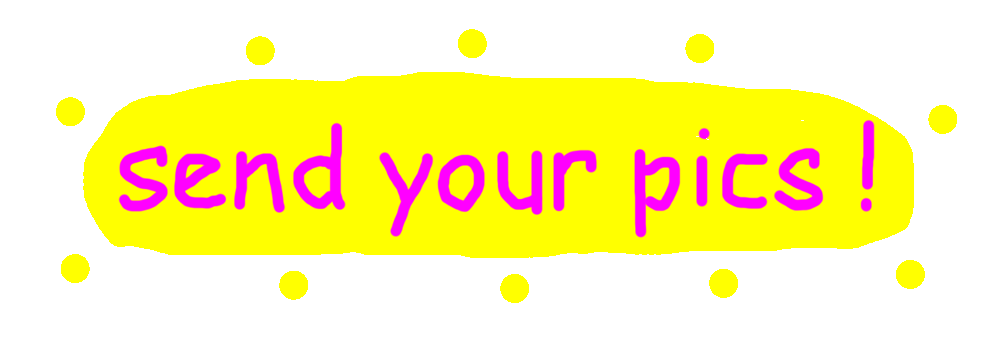
This is a dirty fairytale about memetics, art and politics.
#MEMEPROPAGANDA is an IRL/URL exhibition project, curated by clusterduck collective and hosted by Greencube.gallery, taking place from the 8th of May to the end of June. The show represents a reflection on the growing role of memes in digital society, critically examining their wide reaching impact on contemporary aesthetics, politics and academia. #MEMEPROPAGANDA is also an experiment in collective memetic production, inviting the public to participate in an online Memathon on our imageboard 4ducks, which is hosting the first transnational Meme Character Summit.
The exhibition is conceived as open and participatory, and is divided into two sections: online (ULR) and “in real life” (IRL). During the weeks before the opening, six selected artists have been tasked with designing a set of posters promoting the #MEMEPROPAGANDA exhibition and the greencube.gallery website. You are now in the IRL section of the exhibition, where you can find a cube-map with the posters, as well as a documentation of them being spread in cities around the world. The spreading of the posters and the documentation are an open and ongoing process: which is why, in this section, you can find a link to download all posters in printable format. We invite you to use, print, remix and manipulate this material, both IRL and URL: feel free to spread the posters, use the hashtag #MEMEPROPAGANDA, join the discussion on our imageboard 4ducks, send us your pics and photos, bring your friends and family. Read below if you are interested in learning more, and make sure you don’t miss Geert Lovink’s article: “Overcoming Internet Disillusionment: On the Principles of Meme Design”, which had a defining role in shaping this exhibition.
At least since Donald Trump posted his portrait as Pepe the Frog on Twitter, igniting a discussion about the political use of memes that is still in full swing, the potential role of memetic signifiers as powerful means to steer communication and build mass consent has become clear. Like advertising, which arose from the development of modern propaganda techniques and their application to the emerging technologies of radio, cinema and television, memetics seduce us with an ineffable promise of new insights about semantic manipulation in the age of social and digital splintering.
Parallels can be drawn between the use of early psychology’s insights for the exploitation of public desires through marketing techniques, and the platform economy’s current obsession with attention management. Likewise, new art forms emerging around meme culture have often been compared to pop-art for their ironic use of mainstream cultural iconography and their twisted obsession with consumerism’s aesthetics. However, the different role of authoriality and the new centrality of prosumerism in the age of digital social networks mark a clear distinction between the two aforementioned artistic currents, questioning the legitimacy of traditional curatorial approaches.
If, to a certain extent, and as duly noted by most observers, memes show many of the characteristics of a subculture - such as exclusivity, aesthetic refinement and linguistic opacity - when we take the extent of their impact into account, this comparison appears reductive, to say the least. We think that it is now more urgent than ever to understand, analyze and disseminate the knowledge that memetics imply. If it is true that these small, seemingly trivial semantic artifacts can contribute to overthrow the power of traditional establishments, spreading meme knowledge becomes an act of political education. #MEMEPROPAGANDA therefore wants to transcend the obsolete contraposition between the so-called normies, exponents of the vexed mainstream, and the so-called autistics, self-proclaimed guardians of an "authentic" memetic culture. We want to deepen the reflection on the implications and value of the various memetic currents, from edgy to wholesome.
#MEMEPROPAGANDA wants to take the aforementioned developments into account, adopting a position comparable to that of an anthropologist studying urban subcultures: through participant observation, the exhibition will attempt to act as catalyst for memetic processes. However, we will not pretend to be neutral in this process: we maintain that the stakes are too high, and the potential outcomes too wide-reaching, to concede ourselves the luxury of indifference. We will have our heroes, our princesses and princes, and of course our villains: but you might be surprised in discovering that heroes can fail, princesses and princes can be evil, and villains might be our only hope.
Behold the magnificent world of #MEMEPROPAGANDA: a world where meme characters interact with us, ceaselessly entertaining, provoking, confusing and enchanting us. They can be frogs, bears, humans, monsters, freaks, or something entirely different: what they all have in common, is their capacity to become mirrors, reflecting our very own desires and fears, our miseries and our dreams. They are precious instruments, and powerful beings; but most of all, they are what we want them to become.





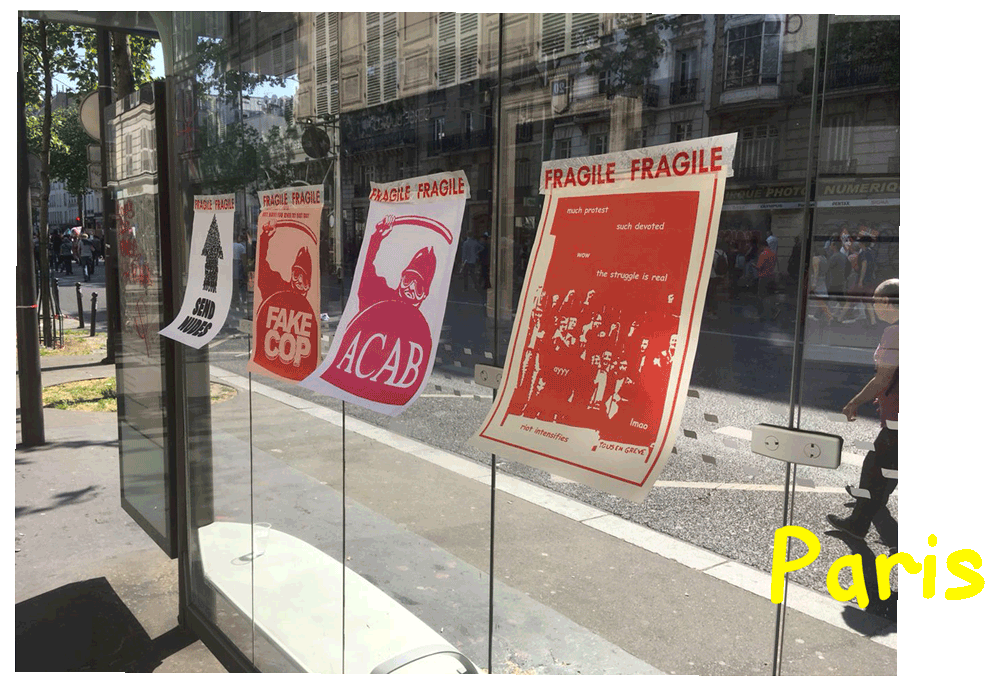
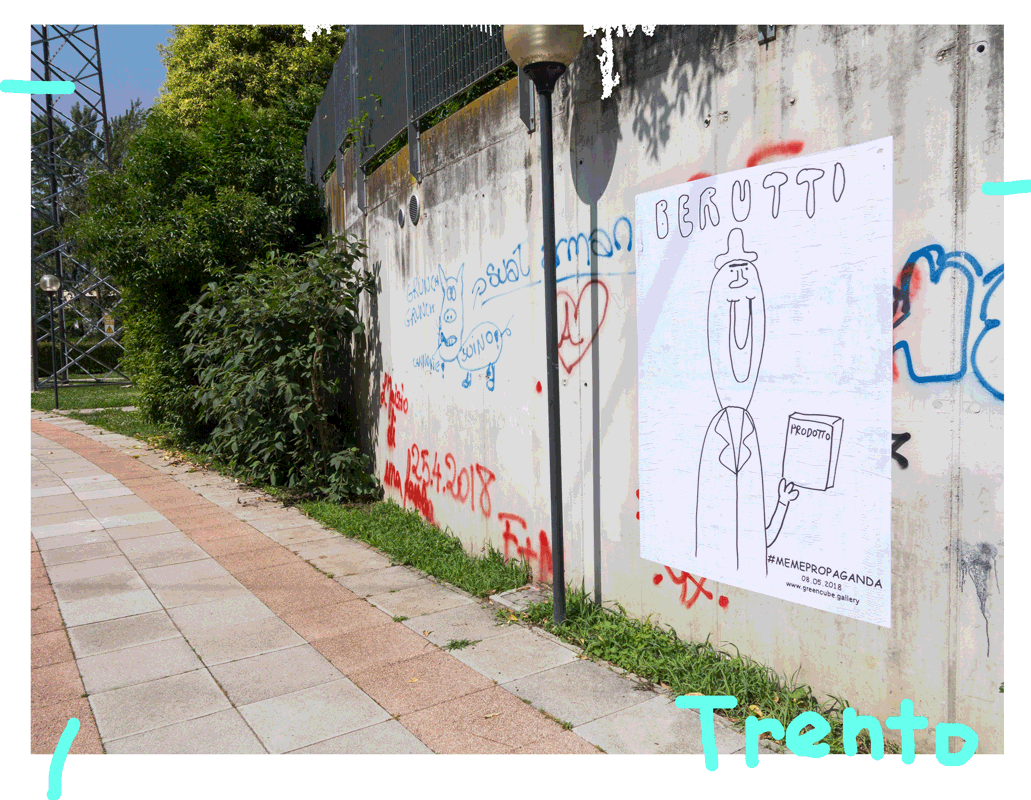



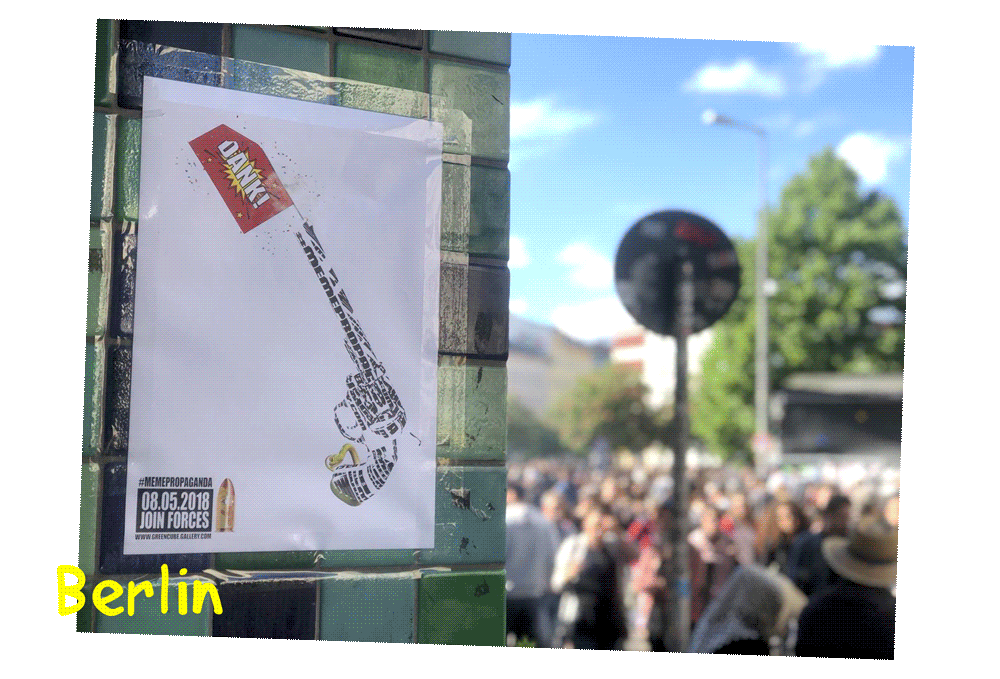


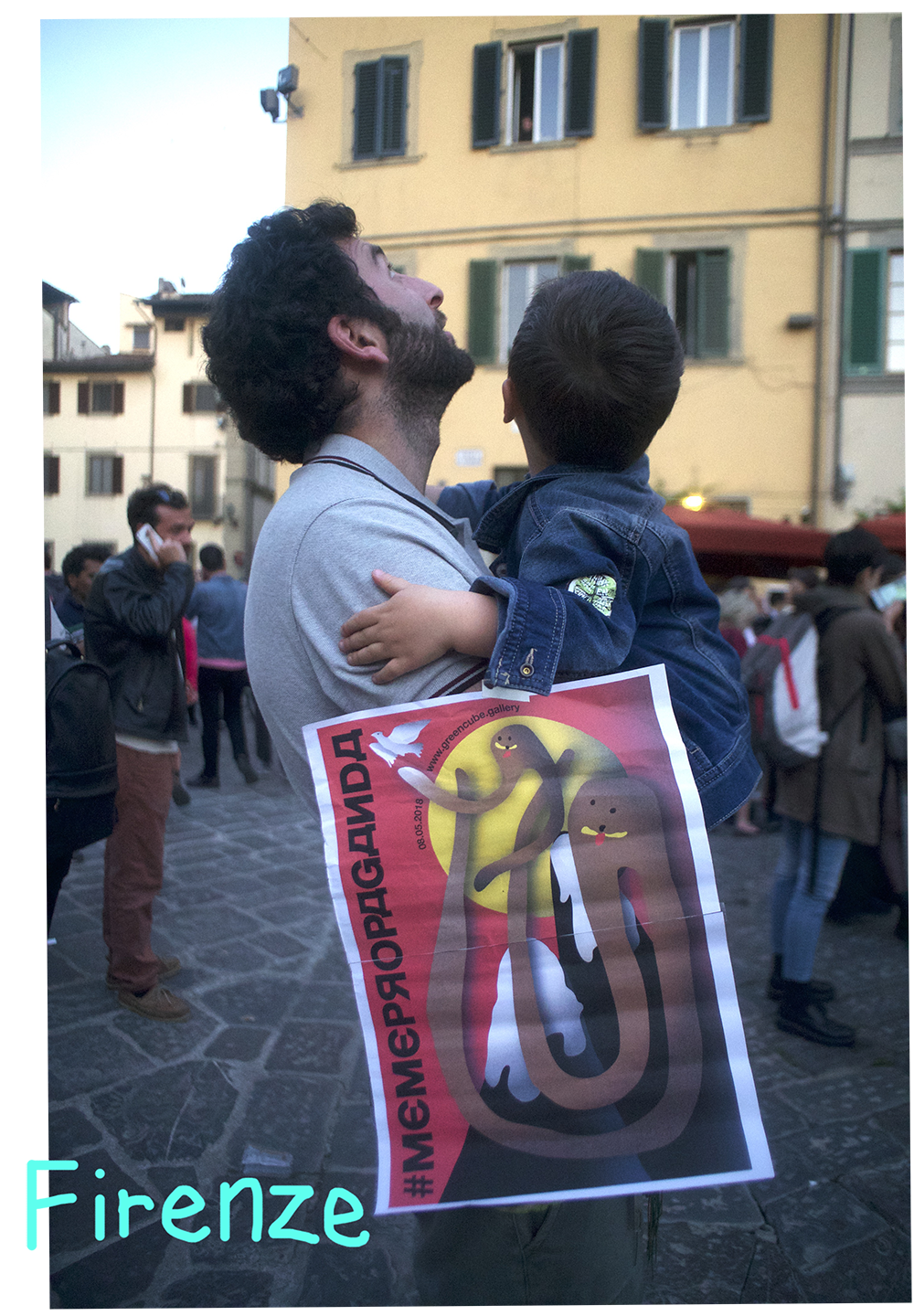




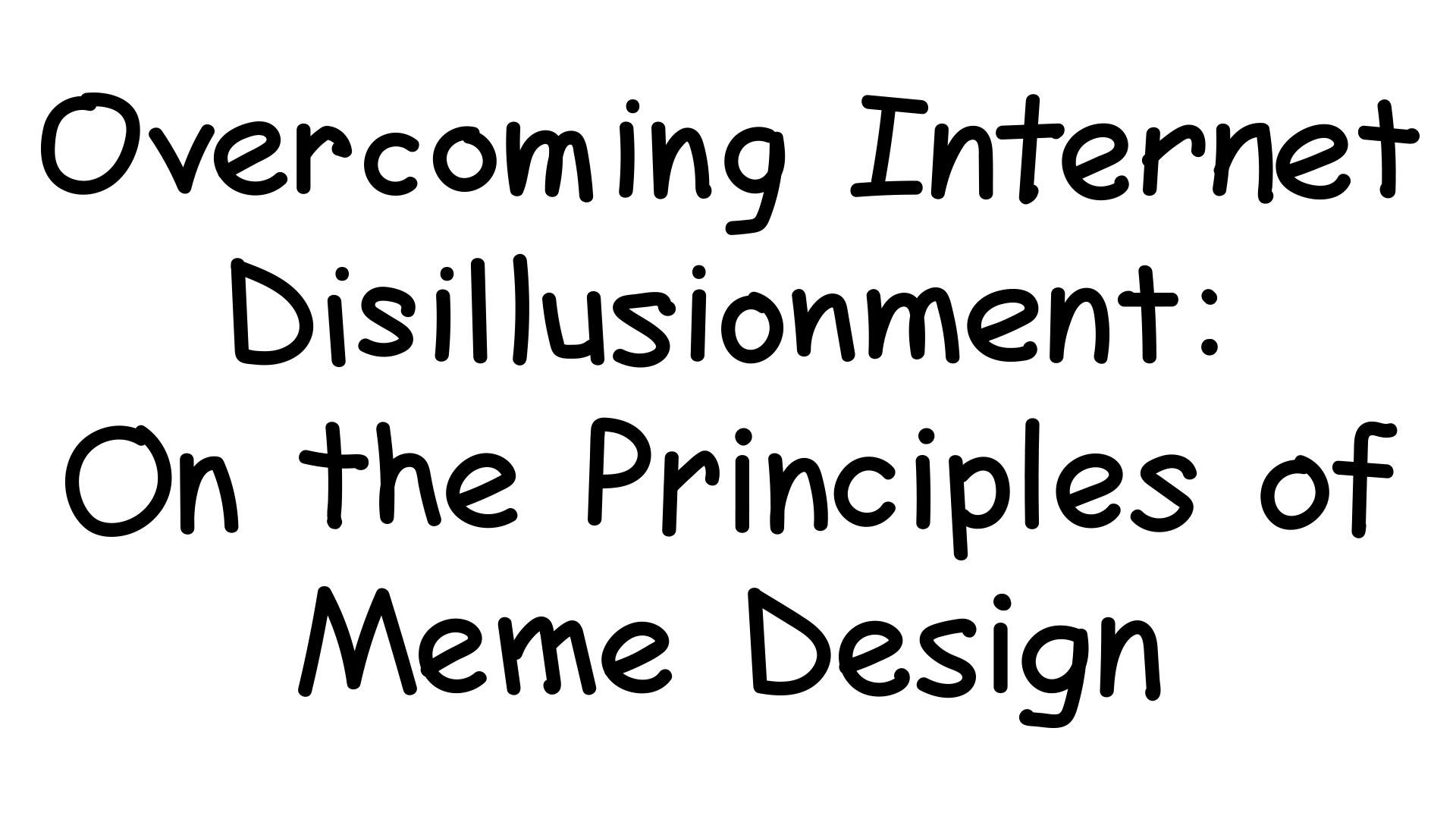
By Geert Lovink
Originally published on e-flux.com
“Artificial intelligence is not the answer to organized stupidity”—Johan Sjerpstra. “Please don’t email me unless you’re going to pay me”—Molly Soda. “Late capitalism is like your love life: it looks a lot less bleak through an Instagram filter”—Laurie Penny. “Wonder how many people going on about the necessity of free speech and rational debate have blocked and muted trolls?”—Nick Srnicek. “Post-truth is to digital capitalism what pollution is to fossil capitalism—a by-product of operations”— Evgeny Morozov. “I have seen the troll army and it is us”—Erin Gün Sirer.
1. Internet Disillusionment
Our disenchantment with the internet is a fact. Yet again, enlightenment does not bring us liberation but depression. The once fabulous aura that surrounded our beloved apps, blogs, and social media has deflated. Swiping, sharing, and liking have begun to feel like soulless routines, empty gestures. We’ve started to unfriend and unfollow, yet we can’t afford to delete our accounts, as this implies social suicide. If “truth is whatever produces most eyeballs,” as Evgeny Morozov states, a general click strike seems like the only option left. But since this is not happening, we feel trapped and console ourselves with memes. The multi-truth approach of identity politics, according to Slavoj Žižek, has produced a culture of relativism. Chomsky’s process of “manufacturing consent” has taken hold completely. As Žižek explains in a British TV interview, the Big Other has vanished. There is no BBC World Service anymore, the moderate radio voice that once provided us with balanced opinions and reliable information. Every piece of information is self-promotion, crafted by public-relations managers and spin doctors—and by us users as well (we are our own marketing interns). What’s collapsing right now is the imagination of a better life. It is no longer the “wretched of the earth” who revolt, because they’ve got nothing left to lose, but rather the stagnating middle class and “young professionals,” who face permanent precarity. After hubris come guilt, shame, and remorse. Mass conformity didn’t pay off. The question is how the current discontent will ultimately play out on the level of internet architecture. What is techno-repentance? What comes after the Exorbitant Detriment?
Once the love affair with apps is over and the addiction reveals itself, the mood flips to cold turkey. What some see as a relief is experienced by many as frustration, if not hatred. The online Other cannot possibly be classified any longer as a “friend”: “If people in the outside world scare you, people on the internet will downright terrify you” is a general warning applicable to all websites.

Users are under constant risk of financial collapse, and once they’re poor, they will be subjected to the post-money economy in which only imaginary entities circulate. After they’re written off, being online is their last refuge. “We’re terrofucked.” That’s how Jarett Kobek sums up the general feeling in his 2016 novel I Hate the Internet. The guilt and frustration is both personal and political, on a global scale. Throughout the story, set in the gentrified streets of San Francisco, computers coordinate the exploitation of “the surplus population into perpetual servants.” What happens once the realization sinks in that “all the world’s computers were built by slaves in China” and that it is you who is using those same devices? What happens when we’re personally addressed as the guilty partners, “suffering the moral outrage of a hypocritical writer who has profited from the spoils of slavery”?
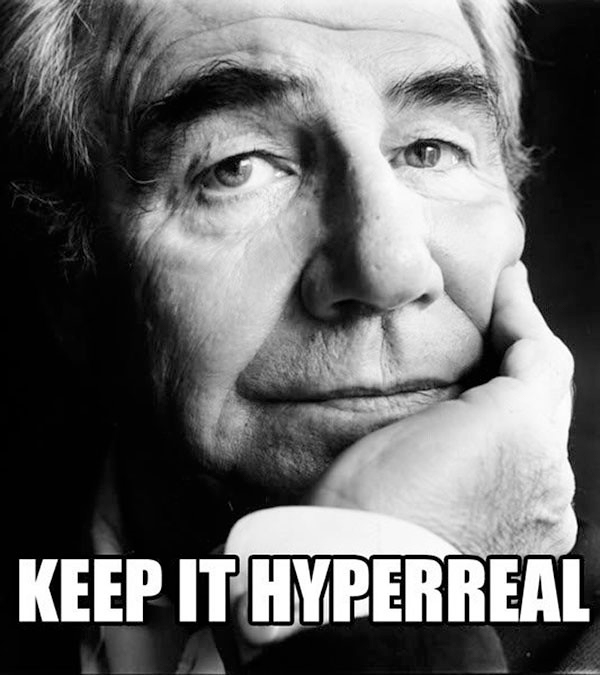
This is the intriguing part of Kobek’s DIY philosophy, which he presents as a science fiction of the present. What if the current internet economy of the free is the default future scenario for the 99 percent? What will happen when the concentration of power and money in the hands of the few becomes irreversible and we abandon all hope for the redistribution of revenues? For Kobek, this is already the case. Failed traditional money has been replaced by micro-fame, “the world’s last valid currency,” which is even more subject to oscillations than old-fashioned money. “Traditional money [has] ceased to be about an exchange of humiliation for food and shelter.
Traditional money [has] become the equivalent of a fantasy world.”Kobek calls himself a proponent of the “bad novel,” in contrast to CIA-sponsored literary fiction from the Cold War, called the “good novel”—a category which continues to exist in the form of Jonathan Franzen, who writes “about people from the American Middle West without much eumelanin in their epidermises.” Bad novels are defined here as stories that “[mimic] the computer network in its obsession with junk media, in its irrelevant and jagged presentation of content,” filled with characters that have a “deep affection for juvenile literature” such as Heinlein, Tolkien, and Rand. This all makes you wonder in which category Dave Eggers’s novel The Circle—an update of Orwell’s 1984—would fit. Can Eggers’s internet novel about Minority Report–style measures enforced by a fictitious company that’s a cross between Google and Facebook be classified as the ur–bad novel of this type?

The promise of fame deluges people with images of grotesque success. Everyone is a performer and a celebrity, as long as they believe in their dreams and strive to be like Beyoncé and Rihanna, who are inspirations rather than vultures. Such celebrity cases show “how powerless people [demonstrate] their supplication before their masters.” Fans are fellow travellers on a journey through life; they are not consumers that purchase a product or service. According to Kobek, “the poor [are] doomed to the Internet, a wonderful resource for watching shitty television, experiencing angst about other people’s salaries.” Built by “pointless men,” the net invokes nothing but trash and hate, leaving the poor empty-handed, with nothing to sell. The poor make money for Facebook. It will never be the other way round. Kobek has been compared with Houellebecq because of the harshness of each writer’s characters. In I Hate the Internet, we wander through the cynical start-up environment of Silicon Valley, but Kobek shies away from taking us inside. Unlike the cyberpunk novel, we do not enter cyberspace; we don’t swipe through profiles or flow through Instagram pictures. This is not about an “illusion of the end” (and that’s the main difference from the 1968 generation: we have the uncanny feeling that something has barely started). In this hyperconservative era, we no longer confront ourselves with the historical duty to face the end of the welfare state, neoliberalism, globalization, the European Union, or other modern institutions. Instead, we’re lured into a perpetual state of retromania, because, as the late Mark Fisher pointed out, it is the present that has gone missing (“Make America Dank Again”). Pseudo-events have no chronology, no development, no beginning or middle, let alone an end. We’re beyond the terminal process, beyond the postmodern patchwork. Everything accelerates. This must be the twenty-first-century-style catastrophe that so many films have introduced us to. Still, we remain encapsulated, captured inside cybernetic loops that go nowhere, in which meaningless cycles of events, series, and seasons pass by. What happens when the anxiety of information saturation flips into a profound feeling of emptiness? Once we’ve passed this point, the digital neither disappears nor ends. Events simply no longer turn into Roman spectacles. Instead, we experience simulacrum as prime reality. We cannot process such a sudden overproduction of reality. We no long turn on television news thinking that we’re watching a film. We’ve moved on. It is not life that has become cinematographic; it is film scenarios and their affects that shape the grand designs of our technological societies. Films anticipated our condition, and now we’re situated in the midst of yesteryear’s science fiction. Minority Report is now a techno-bureaucratic reality, driven by the integration of once-separate data streams. Virtual reality feels like The Matrix. Trump’s reality TV show proved to be a rehearsal. The logic of the avant-garde is very much alive. The last industry to deal with the fake and real whirlpool is the news industry. Hyperreality becomes our everyday situation—regardless of whether we perceive it as boring or absurd.

Let’s look at radical disillusionment as form and celebrate the return of its high priest, Jean Baudrillard. Our social media rage is not just a medical condition of the few; it is the human condition. Will the disenchantment turn into a revolt, as Camus once contemplated? The spiritual exhaustion is certainly there (#sleepnomore). Empty-handed, we discuss one powerless critique of the database form after another. To put it in spatial terms, cyberspace has turned out to be a room containing a house containing a city that has collapsed into a flat landscape in which created transparency turns into paranoia. We’re not lost in a labyrinth but rather thrown out into the open, watched and manipulated, with no center of command in sight. The mille plateaux of tweets, blogs, and Instagram and Facebook postings have created a culture of deep confusion. Fragmentation was supposed to enrich us, so why are we now paying the bill for all its unforeseen consequences? This was not supposed to happen. Is this the “difference” we once aimed for? Mainstream media play a crucial role in this process of decay. While their legitimacy has faded, their influence is still believed to be significant. This creates an atmosphere of permanent ambivalence. Why bother? Their role as “clearinghouses” of facts and opinion has been undermined for decades by growing centrifugal forces in society that no longer accept particular baby-boomer sentiments (and interests) as the legitimate consensus. The stunning inability of “the press” to deal with recent changes in society has lead to a widespread form of indifference. The theoretical blind spots of successive postmodern generations are too numerous to list. The elephant in the room here is Jürgen Habermas. Many of us still subscribe to his notion of the bourgeois public sphere as an arena where different opinions compete in a rational dialogue—even if we do not believe in the core values of Western society, such as democracy. And who’s the “counterpublic” in this context? The “user-generated content” of 4Chan, Reddit, and YouTube? What’s the organized answer to all this? What would a contemporary version of Indymedia look like? And if such a federated model of “independent media” is so 1999, then why is it so hard to put together a 2017 upgrade? There is a crisis of “participatory culture.” Let’s look at the example of danah boyd and how she’s deconstructing the “media literacy” discourse for which so many had such high hopes. The cynical reading of the news has overshadowed critical capacities. In the aftermath of Donald Trump’s election, boyd asked if media literacy had backfired. Have trolling, clickbait, and fake news undermined the classic belief in the democratization of news production? Whereas for the pre-internet baby-boom generation media literacy was synonymous with the ability to question sources, deconstruct opinions, and decode ideology, media literacy has now turned into the ability to produce one’s own content in the form of responses, blog postings, and social media updates. The shift from critical consumer to critical producer has come with a price: namely, information inflation. (The well-meaning “prosumer” synthesis never materialized.) According to boyd, media literacy has became synonymous with distrusting media sources rather than engaging in fact-based critique. Instead of examining the evidence of experts, it is now enough to cite one’s own personal experience. This has led to a doubt-centric culture that can only ever be outraged, a culture incapable of reasonable debate—a polarized culture that favors tribalism and self-segregation. The current situation demands a rethink of the usual demands of activists and civil-society players regarding media literary. How can the general audience be better informed? Is this an accurate diagnosis of the current problem in the first place?

How can “do-it-yourself” be a viable alternative when social media is already experienced in those terms? And can we still rely on the emancipatory potential of “talking back to the media” via the familiar social networking apps? How does manipulation work today? Is it still productive to deconstruct the New York Times (and its equivalents)? How would we explain the workings of the Facebook News Feed to its user base? If we want to blame the algorithms, how do we translate their hidden complexity so that large audiences can understand them? An effort at such translation is Cathy O’Neil’s Weapons of Math Destruction: How Big Data Increases Inequality and Threatens Democracy, in which she describes how “ill-conceived mathematical models now micromanage the economy, from advertising to prisons.” Her question is how to tame, and disarm, dangerous algorithms. These mathematical models are not neutral tools. However, in everyday life we increasingly experience ranking as destiny. Coining the term “Weapons of Math Destruction,” or “WMDs,” O’Neil writes: “Promising efficiency and fairness, [WMDs] distort higher education, drive-up debt, spur mass incarceration, pummel the poor at nearly every juncture, and undermine democracy.” In her account of the jobs she has had in numerous algorithm-focused industries, she shows that this software is “not just constructed from data but from the choices we make about which data to pay attention to—and which to leave out. Those choices are not just about logistics, profits, and efficiency. They are fundamentally moral.” And class-biased, she adds: “The privileged are processed by people, the masses by machines.” Once installed and running for a while, these WMDs create their own reality and justify their own results, a model which O’Neil calls self-perpetuating and highly destructive.

Techniques such as leaks, fake news, socialbots, kompromat, and agitprop confuse the political climate. Disorientation is sufficient; it is not longer necessary to, for instance, manipulate election outcomes. In this “post-factual era,” we’re left with the instant beliefs of celebrity commentators and media experts. Look at Donald Trump’s tweets, an ultimate form of media literacy and a perverse flood of self-expression. His personal tweets have become indistinguishable from policy, state propaganda, and info warfare. In this case, power no longer operates through the pornographic overexposure of the hi-res 3-D image. This is not big data, but singular data. Tiny messages with a “tremendous” fallout. At this level, we leave behind the realm of both Hollywood glamour and reality TV and enter the real-time realm of communication-with-consequences, a next-level hybrid in which sovereign executive power and marketing become inseparable. What does contemporary psychoanalysis have to offer? As evidenced in Kristin Dombek’s The Selfishness of Others: An Essay on the Fear of Narcissism, there is a renaissance of narcissism as cultural diagnosis. While Dombek avoids referencing internet cultures and refrains from selfie and social media complaints, she does point to a crucial change in psychoanalytic practice: from therapeutic to quantitative methods. Today’s narcissism is social and contagious in nature; it consists of traits that “can be measured across large groups of people.” Generation Me spans the planet. We need to move beyond the illness metaphors when discussing Trump, the alt-right, and social media at large. It could be a fatal mistake to attempt to marginalize (as both diagnostics and tactics) the self-absorbed populist right as “sick patients.” In a review of The Selfishness of Others, Jennifer Schuessler writes that “Ms. Dombek’s own view echoes that of the philosopher René Girard, who argued that our tendency to see narcissism in parents and partners is an effort to reassure ourselves that if those we desire are less than ideally responsive to us it’s because they are sick, not because we are uninteresting.”Beyond the fear of narcissism, let’s look at Trump again, a man who “seems supremely cognizant of the fact that he is always acting. He moves through life like a man who knows he is always being observed.” This quote is taken from “The Mind of Donald Trump,” a June 2016 piece in The Atlantic written by Dan P. McAdams. Here, Trump is described as a “flummoxing” figure, exhibiting sky-high extroversion combined with off-the-charts low agreeableness. He’s portrayed as a dynamo—driven, restless, unable to sit still, getting by with very little sleep. A cardinal feature of Trump’s acute extroversion is his relentless reward-seeking. Prompted by the activity of dopamine circuits in the brain, highly extroverted people are driven to pursue positive emotional experiences. As McAdams writes, Anger can fuel malice, but it can also motivate social dominance, stoking a desire to win the adoration of others. Anger lies at the heart of Trump’s charisma, dominated by ebullient extroversion, the relentless showmanship, and the larger-than-life celebrity, who never thinks twice about the collateral damage he will leave behind.

Repeated and inordinate self-reference is a distinguishing feature of their personality. Over time, people become annoyed, if not infuriated, by their self-centeredness. When narcissists begin to disappoint those whom they once dazzled, their descent can be especially precipitous. There is still truth today in the ancient proverb “Pride goeth before the fall.” The world is saturated with a sense of danger and a need for toughness: the world cannot be trusted. It is a ferocious combatant who fights to win. Are you preoccupied with fantasies that the world is ending because of the selfishness of others? McAdams: Who, really, is Donald Trump? What’s behind the actor’s mask? I can discern little more than narcissistic motivations and a complementary personal narrative about winning at any cost. It is as if Trump has invested so much of himself in developing and refining his socially dominant role that he has nothing left over to create a meaningful story for his life, or for the nation. It is always Donald Trump playing Donald Trump, fighting to win, but never knowing why.

Let’s seek out a secular follow-up to the critique of religion. What is atheism in the information context? The multiplicity of sources and points of view, once celebrated as a “diversity of opinion,” has now reach a nihilistic “zero point” in which the accumulation of possible meanings can either lead to critical insights (or even knowledge), or implode into a pool of indifference (possibly resulting in the disappearance of networks such as Twitter, which thrive on individual expressions, judgements, and preferences). These days, institutional dogmas are hidden inside media folklore, hardwired into network architectures, steered by algorithms. The mental rejection of authority is now so widespread, and has sunken so far into daily routines and mentalities, that it’s now irrelevant whether we deny, endorse, or deconstruct a particular piece of information. That’s the tricky aspect of the current social media disposition. Meme producers have become immune to the criticism of third-way liberal moralists. Their firewall of indifference has not yet been hacked. Ironic deconstruction isn’t doing the job either. Says Tara Burton: “Given the ideological anarchy inherent in shitposting, it tends to defy analysis. Shitposters, who are bound by nothing, set a rhetorical trap for their enemies, who tend to be bound by having an actual point.” Burton concludes that “shitposting can’t be refuted; it can only be repeated.” This is simply not the age of the Renaissance (Wo)Man. The disillusionment is overwhelming.
A meme posted at loltheorists.livejournal.com.
2. Defining the Rules of Meme Design
We’re overwhelmed by media events that unfold in real time. Is this spectacle a smoke screen for more drastic, long-term measures? What’s our own plan? The politically correct strategies of “civil society” are all well-meaning and target important issues, but they seem to operate in a parallel universe, unable to respond to the cynical meme design that is rapidly taking over key sites of power. Are there ways to not just hit back but also be one step ahead? What’s on our minds? How can we move from data to Dada and become a twenty-first-century avant-garde, one that truly understands the technological imperative and shows that “we are the social in social media”? How do we develop, and then scale up, critical concepts and bring together politics and aesthetics in a way that speaks to the online millions? Let’s identify the hurdles, knowing that it’s time to act. We know that making fun of the petty world of xenophobes isn’t working. What can we do other than coming together? Can we expect anything from the designer as lone wolf? How do we organize this type of political labor? Do we need even more tools that bring us together? Have you already used Meetup, Diaspora, DemocracyOS, and Loomio? Do we perhaps need a collective dating site for political activism? How can we design, and then mobilize, a collective networked desire that unites us in a “deep diversity”? Is the promise of open, distributed networks going to do the job, or are you look for strong ties—with consequences? Generations have studied the fatal mistakes made in the interbellum years, but what are the conclusions, now that we’re entering similar territory? It’s time to reread Hannah Arendt’s The Origins of Totalitarianism (in which we find David Rousset’s famous quote: “Normal men do not know that everything is possible”). We should also revisit Wilhelm Reich’s Mass Psychology of Fascism, Adorno and Horkheimer, Elias Canetti’s Crowd and Power, and the opus that defined my own intellectual destiny, Klaus Theweleit’s Male Fantasies. This is a subjective list; there are so many other classics in this genre. Will these authors assist us in discovering the defining factors of our age? How can we identify these key issues and then act upon this knowledge? Crucial are alternative narratives, which, once they have been developed and tested, can be condensed into memes. As we know, memes can and must be mutated. This means that the overall narrative will have to be robust (while “agile”). Memes are designed to be jammed, yet the core message stays the same no matter how radically the meme is altered. We can also call this condensed semiotic unit a symbol, although the symbolic aspect of a meme often remains invisible.

The Billbord Liberation Front has, in the spirit of culture jamming, been "improving" outdoor advertising since 1977. Prior campaigns have targeted ads by Exxon, R. J. Reynolds, and Apple Computers. As soon as we understand resistance as organized interference, we can start doing counter-mapping, monitoring the silence and bringing out the hysterical realism that has been hidden for so long. We need to blast lasting holes in the self-evident infrastructure of the everyday. As we have learned from Silicon Valley business gurus, disruption is enough to bring down vast systems, which really just consist of meaningless routines. It’s much easier than we think. This also brings closer the possibility of revolution—an event that even the most dogmatic critics of the neoliberal regime ruled out ages ago. In preparation for things to come, I asked a few people the perennial question: what is to be done? I started off with Nick Srnicek, coauthor of Inventing the Future, who just published a treatise called Platform Capitalism. According to him, we should start getting into the habit of blocking users on social media. “The basic idea on social media also holds for broader issues of public debate: how to refuse voices that are purposefully attacking the basis of reasonable debate?” Eva Illouz, author of Why Love Hurts and Cold Intimacies, argues that we need to start with the question of how to design truth: The problem is that they fight with lies. They have no moral limits. Immoral fighters have an advantage because they are not constrained. We would have to counteract with truth, but truth is binding and constraining, so the question is, how do you make truth as powerful or more powerful than lies, which have the advantage of being invented quickly and tailored to meet your needs? A possible answer lies in the refusal to deal with memes as isolated digital objects that can be reassembled randomly. We should not start at the very end and get stuck on the Know Your Meme pages. Srnicek: We need new stories, and that’s different from just thinking about counter-memes or stopping the flow of information. It’s a different temporality effectively, but a new narrative then provides the basis for more immediate responses via social media, memes, etc. There is a narrative to Trump and the rising far right, for instance. And it’s a seductive narrative for some people, which then gets expressed in various forms. The left is, mostly, missing that narrative. We need to get to the heart of the matter, rather than attempting to deal with symptoms. There is all this effort to block “fake news,” but no one questions why the public has a new demand for these stories, or why they don’t have the critical capacity to spot them. Just changing some newsfeed algorithms doesn’t seem adequate.

The cry for new narratives coincides with calls to go “beyond the fragments,” as expressed by Jodi Dean in her 2016 book Crowds and Party. Can memes play a role in the centripetal social forces that bring us together? Dean: It will be a good experiment to see if meme wars can be effective in undermining the right (that is, making them appear unappealing and undesirable to potential supporters). The challenge is creating bubble-breaking memes since most memes tend to circulate within bubbles of people who already agree. But even if your memes don’t break bubbles they can still be effective if they inspire the left. Bernie Sanders’ Dank Meme Stash was a fantastic source of fun and inspiration during the US election. Alex Galloway isn’t sure “culture jamming” is as successful a tactic today as it was in the 1990s. “Memes seem to be operating almost entirely under what we used to call ideology. The power and interest that memes have is entirely due to their status as ideological machines, which doesn’t mean they are useless, debased, etc.—on the contrary, it demonstrates how complex and powerful they are.” Johannes Grenzfurthner from the Viennese art collective Monochrom adds: “You need a lot of user/follower/creator-power to really create outreach. 4Chan only became the breeding ground of super-memes because of their sheer endless pool of Darwinian non-archival users, some of them online for almost the entire day—and that for years.” Grenzfurthner also reminds us that creating political memes is a PR approach to internet culture: People sniff out PR very fast. And in the end it can turn against you and your campaign. I understand the need to create easily shareable counter-info-memes, but that’s pretty much already happening. A ton of good images are already circulating in the specific bubbles. But how to get out of the bubble? You can’t penetrate conservative bubbles with liberal content. Your content has to be so obscure and mysterious that it’s not working as a propaganda tool anymore. Or will just be used for ridicule. According to free software thinker and Anonymous historian Gabriele Coleman, we simply cannot afford not to use memes: When the alt-right was gaining ground and various journalists were horrified that images and emotions could “tug” at people and sway them politically, I was equally horrified that they were so naive and negative about emotions and visual culture. Yes, progressives and leftists must include memes and humor in their arsenal to fight back at some quarters of the right and to steer some portion of the Internet-crazed youth toward the left. Without it, we will lose a huge base of people. Whether this can be designed through a group effort or must bubble up from below is a whole other question. My sense is that it would be more effective coming from a subcultural base rather than an elite art vanguard. I also asked Matt Goerzen, who’s doing meme research with Coleman, about the sought-after recipe for a successful meme:

I’ve come to understand image board memes as a toolset that can be put to different uses, but only where they fit the job at hand. Memes can be effectively weaponized, as in shitposting on Twitter, a form of cognitive denial-of-service attack, to use Rand Waltzman’s term. But they’re most powerful as a site of identification, coalescing the values of the individuals who identify with them through thematic sentiment. According to Goerzen, a significant portion of alt-righters devoted their memetic labors to Bernie while he was still in the running. Goerzen noticed that there was almost no attempt to meme for Hillary: It’s worth wondering why that is. My understanding is that memes are sort of a vessel or coordinating point for organization, but without themes they are largely lacking in ideological value. They are like a vocabulary, and need to be animated and organized by an imperative or narrative. The trajectory of Pepe is very instructive in this regard, and I believe it is telling that the Bernie memes that were getting going utilized Wojak. Pepe and Wojak are like yin and yang—where Pepe is rash, manic, provocative, devious, extroverted, Wojak is deliberative, depressive, reserved, empathetic, and introverted. When Bernie was eliminated the positive identifications enabled through Wojak were stalled, while the positive identifications enabled through Pepe to Trump gained extra momentum, as many of the chan Bernie supporters were enraged by the foul play they deemed responsible for his disqualification—essentially Pepifying them. This is just one example, but the point is this: I believe the effective way to weaponize memes for ideological purposes is to steer ones already popular and meaningful for a contested demographic. This aligns with the “redirect method” that attempts to counter violent extremism circles. The idea of designing or topdowning memes (or “forcememing” in the parlance of imageboard culture) is a pretty challenging task. Many of the government types I’ve spoken with in elucidating these questions over the past months have ideas about how this can be done, but it involves pretty vast resources, and more resembles the sort of work done by Cambridge Analytica than anyone in the imageboard or alt-right cultural orbit. Apart from the need for a narrative, there’s the issue of acceleration. Should alternative memes circulate at the same speed as the overall internet? Are we running out of time? How about slow memes? What if “real time” is itself part of the problem? According to Franco Berardi, we need a new rhythm of elaboration; we need to slow down sequentiality, heal from acceleration, and find a new tempo of movement. This cannot be realized through further acceleration. Real-time communication already ruins our bodies, our minds. According to Berardi, the digital realm is leading to “decorpetization,” creating a “bodiless brain.” The infosphere is one giant nervous stimulation. What we need, before we can even start telling the New Narrative, is a “reconfiguration of mental elaboration.”
Geert Lovink is a Dutch media theorist, internet critic, and author of Uncanny Networks (2002), Dark Fiber (2002), My First Recession (2003), Zero Comments (2007), Networks Without a Cause (2012), and Social Media Abyss (2016). In 2004 he founded the Institute of Network Cultures at the Amsterdam University of Applied Sciences. This center organizes conferences, publications, and research networks such as Video Vortex (online video), Unlike Us (alternatives in social media), Critical Point of View (Wikipedia), Society of the Query (the culture of search), MoneyLab (internet-based revenue models in the arts). Recent projects deal with digital publishing and the future of art criticism. He also teaches at the European Graduate School (Saas-Fee/Malta), where he supervises PhD students.© 2017 e-flux and the author
